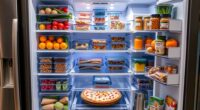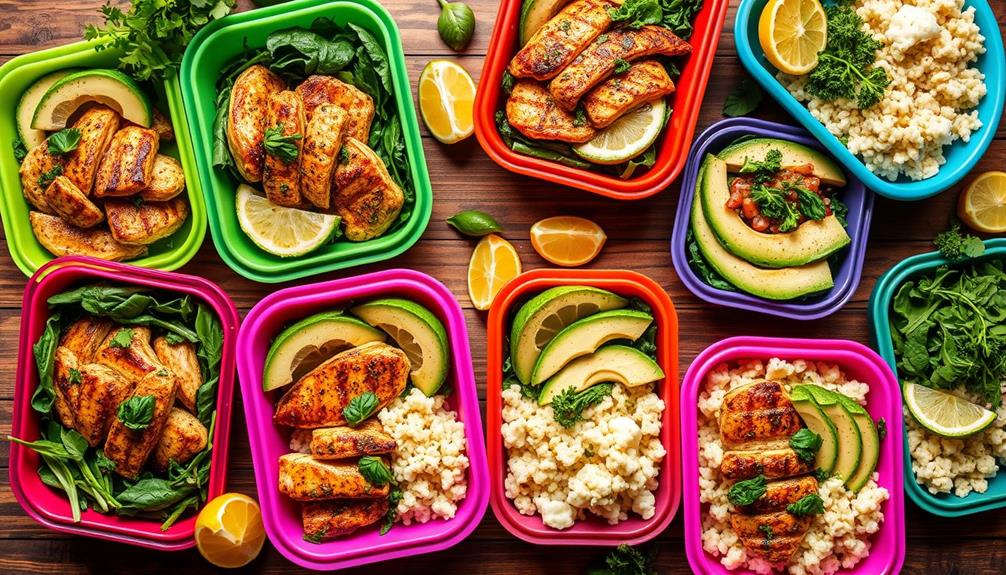When prepping meals, store fruits and veggies in airtight or perforated containers in the fridge’s crisper drawer, keeping different produce separate to avoid spoilage. Wash your hands, tools, and surfaces often, and use separate cutting boards for raw meat and produce. Reheat leftovers to at least 165°F, covering and stirring for even heating, and consume promptly. Proper storage and reheating methods help keep your meals safe and fresh—learn more to master these essential tips.
Key Takeaways
- Wash and dry produce thoroughly before storing to prevent spoilage and cross-contamination.
- Store leftovers in airtight containers and reheat to at least 165°F for food safety.
- Keep raw meats separate from produce and ready-to-eat foods to avoid cross-contamination.
- Reheat leftovers evenly, using a thermometer to ensure the proper internal temperature is reached.
- Consume reheated meals promptly and avoid leaving leftovers at room temperature for over two hours.

Preparing your meals in advance can save time and promote healthier eating, but it also requires careful attention to food safety. One of the most vital aspects is how you store and handle fresh produce. When you prep fresh fruits and vegetables ahead of time, make sure you wash them thoroughly under cold running water. This helps remove dirt, bacteria, and pesticides. Dry them with a clean cloth or paper towel before storing to prevent excess moisture, which can lead to spoilage. Store fresh produce in airtight containers or perforated bags in the refrigerator’s crisper drawer. Proper storage not only preserves their freshness but also minimizes cross-contamination with other foods. Keep different types of produce separate, especially those prone to spoilage, to maintain quality and safety. Food storage practices are essential to extend shelf life and reduce waste.
Maintaining excellent kitchen hygiene is essential to preventing foodborne illnesses. Always wash your hands thoroughly with soap and water before handling any ingredients, and clean all surfaces, utensils, and cutting boards regularly. Use separate cutting boards for raw meats and produce to avoid cross-contamination. When prepping, wipe down countertops with an antibacterial cleaner or a solution of vinegar and water. After preparing produce or cooked meals, promptly wash dirty utensils and containers to prevent bacterial growth. Good kitchen hygiene also involves keeping your refrigerator clean and at the right temperature—ideally below 40°F (4°C). Regularly check for expired or spoiled items and discard them immediately. This routine reduces the risk of bacteria spreading to your stored meals.
Reheating is another essential step in food safety, especially when you’re reusing prepped meals. Always reheat leftovers to an internal temperature of at least 165°F (74°C). Use a food thermometer to verify this, because visual cues like steam or bubbling aren’t reliable indicators. When reheating, cover your food to trap heat evenly and prevent bacteria from contaminating the surface. Avoid reheating multiple times; instead, divide large portions into smaller containers to reheat only what you’ll consume. If you’re using a microwave, stir the food during reheating to ensure even heat distribution. After reheating, consume the meal promptly, and don’t leave it out at room temperature for more than two hours. Proper reheating not only kills bacteria but also preserves the texture and flavor of your prepped meals, making your food safe and enjoyable.
Frequently Asked Questions
How Long Can I Safely Keep Cooked Meals in the Fridge?
You can safely keep cooked meals in your fridge for 3 to 4 days. Make sure to practice food rotation by consuming older meals first and always store leftovers in airtight storage containers. Proper storage helps prevent bacteria growth. Label your containers with dates to keep track of freshness. When reheating, guarantee the food reaches an internal temperature of 165°F to keep it safe to eat and prevent foodborne illnesses.
Can I Freeze Cooked Meals for Long-Term Storage?
Freezing cooked meals is like putting your food on a time machine, preserving it for the future. You can definitely freeze meals for long-term storage using proper freezing techniques, which help maintain food quality and safety. Just make sure to store them in airtight containers or freezer bags, label with dates, and use within 3-6 months. This keeps your meals fresh and ready whenever you need them, reducing waste and saving time.
What Is the Best Way to Reheat Meals Without Losing Quality?
To reheat meals without losing quality, you should choose the right method. For quick reheating, use the microwave, stirring or rotating halfway through to prevent uneven heating. For larger portions or to retain texture, oven reheating works best—cover your food and heat at a moderate temperature. Always check that your meal is steaming hot all the way through before eating to guarantee it’s safely reheated and delicious.
Are There Foods I Should Avoid Storing Together?
Ever wondered if your food pairings could cause more harm than good? You should avoid storing certain items together due to storage compatibility issues. For example, keep raw meats separate from cooked foods to prevent cross-contamination. Fruits and vegetables with strong odors can spoil other items quickly. Knowing which foods to store apart helps preserve quality and safety. Pay attention to food pairing guidelines, and your meals will stay fresher longer.
How Do I Prevent Bacterial Growth During Storage?
To prevent bacterial growth during storage, you should focus on cross contamination prevention by keeping raw meats separate from cooked foods. Always select proper containers that are airtight and food-grade to maintain freshness and prevent leaks. Store perishable items at the right temperature, ideally below 40°F, and don’t leave foods out for too long. Regularly check for spoilage and reheat leftovers to the proper temperature before eating.
Conclusion
Think of your meal prep journey as tending a garden. With careful storage and mindful reheating, you nurture your food’s freshness and safety like delicate plants. Each tip acts as sunlight or water, ensuring your meals stay vibrant and healthy. When you follow these simple steps, your kitchen blooms with confidence, and your meals flourish. So, keep these practices close, and watch your food’s safety blossom into a reliable, nourishing harvest every time.









